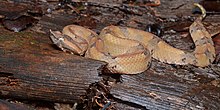|
Porthidium nasutum
Porthidium nasutum is a pit viper species found in southern Mexico, Central America and northern South America. No subspecies are currently recognized.[1][3] Description  Adults are usually less than 40 centimetres (16 in) in total length, and rarely more than 60 centimetres (24 in). Females are considerably larger than males. Moderately stout and terrestrial.[4] Geographic rangeFound in southern Mexico southward through Central America to western Colombia and northwestern Ecuador in South America. Inhabits the Atlantic lowlands from Mexico (Tabasco and Chiapas) through Belize, Guatemala, Honduras, Nicaragua and Costa Rica to eastern Panama and northwestern Colombia. In the Pacific lowlands, it occurs in southwestern Costa Rica, central and eastern Panama, continuing on to northwestern Ecuador. It is found in mesic lowland broadleaf or rainforest from sea level to elevation of about 900 metres (3,000 ft). The type locality given is "Pansos [Panzós], sur les bords du Polochic [Alta Verapaz] (Guatémala)."[2] Conservation statusThis species is classified as Least Concern (LC) on the IUCN Red List of Threatened Species. It is a widespread and moderately common species that is not facing major threats.[1] References
Further reading
External links
|
||||||||||||||||||||||||||||||||||||||||
Portal di Ensiklopedia Dunia


